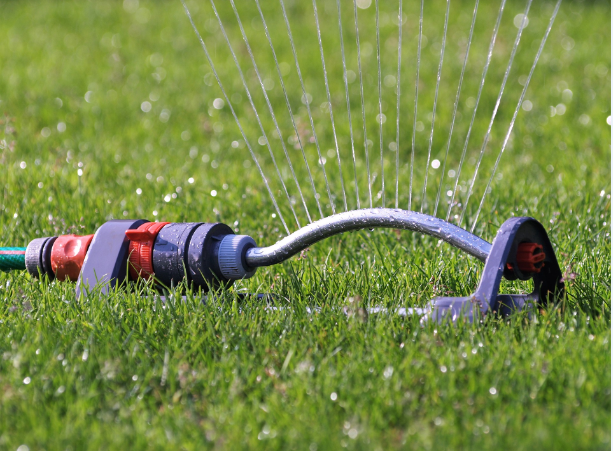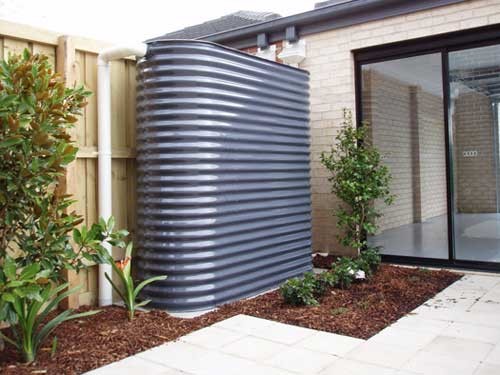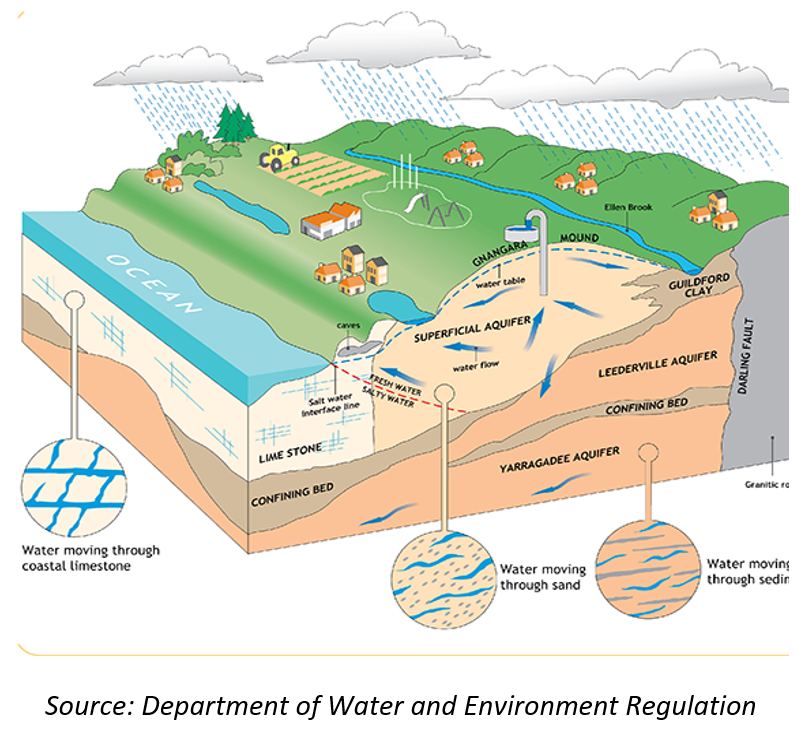Groundwater is water that can be found below the earth’s surface stored in cracks and spaces in soil, sand and porours rocks. Most groundwater sources occur from the accumulation of rain infiltrating through the ground which has accumulated over thousands of years. As a hidden resource, groundwater can sometimes be difficult to percieve and value. One thing we do know is that groundwater is a finite resource and aquifers which store groundwater can become depleted when extraction rates exceed natural recharge rates.
Snapshot: Gnangara Mound, Perth
The Gnangara Mound is Perth’s largest source of good quality, fresh water and plays a crucial role in Perth’s drinking water supply as well as supporting local agriculture, open spaces, gardens, wetlands and native vegetation. Four main aquifers make up the Gnangara Mound:
- A shallow superficial aquifer (Gnangara Mound)
- A shallow semi-confined aquifer (Mirrabooka Aquifer)
- A deep confined aquifer (Leederville Aquifer)
- A very deep confined aquifer (Yarragadee Aquifer)
Groundwater in the Gnangara Mound is replenished by rainfall which percolates down through soil and rocks to enter the aquifer. Groundwater levels in the Gnangara Mound have declined over the past 40 years as a result of reduced rainfall and an increase in consumption.
Allocation and Use of Groundwater
The Department of Water and Environmental Regulation (DWER) manage commercial water licensing and allocation of groundwater from the Gnangara Mound. In the 2015-16 reporting period the DWER recorded 121.3GL of groundwater was used for public water supply entitlements, 127.2GL of groundwater usage was from private licenses, and 36GL was estimated to be used by garden bores (exempt from licensing).
Groundwater level monitoring of the Gnangara Mound over the 2015-16 reporting period identified 18 vegetation monitoring sites out of 30 which were below the absolute minimum or peak water level criteria, and, six wetland monitoring sites out of 30 which were non-compliant with other water level criteria. This indicates that management and abstraction of groundwater in the mound are not sustainable and persistence of the Gnangara Mound and ecosystems which depend on groundwater, such as Banksia woodlands and wetlands will be adversely affected. It also suggests a fundamental disconnect between groundwater use and management. (The Annual Compliance Report is available to download here).
The DWER have recently stated that tougher water restrictions for residential bore owners could be implemented to reduce drawdown of the Gnangara Mound. This could include changes to sprinkler rosters and encouraging the recycling and reuse of grey water. However, given that residential bores equated to only 36GL of groundwater use from a total of 284.5GL in 2015-16, it raises questions as to why other groundwater users are not also going to face tougher restrictions on their usage as well.
What’s Being Done to Restore and Manage Groundwater?
 The DWER state that the decline of groundwater in the Gnangara Mound is attributed to less rainfall and continued groundwater use. Targeted management is required to ensure the sustainable use of groundwater in the long-term. Several projects are underway which aim to diversify and restore water resources in the Perth Region.
The DWER state that the decline of groundwater in the Gnangara Mound is attributed to less rainfall and continued groundwater use. Targeted management is required to ensure the sustainable use of groundwater in the long-term. Several projects are underway which aim to diversify and restore water resources in the Perth Region.
Direct restoration of groundwater sources is being done through the growing practice of Managed Aquifer Recharge (MAR). This refers to the intentional return of water back into aquifers for recovery and environmental benefits using structures such as injection wells or infiltration structures. The largest MAR project in Western Australia is the Water Corporation’s Groundwater Replenishment Scheme which involves the injection of treated wastewater into the groundwater for further natural water quality processing and storage until it is extracted at a later date. The scheme recycles water, reduces dependence on rainfall and recharges groundwater all at once with the potential to provide up to 20% of Perth’s drinking water supplies by 2060 if development is continued.
A new Gnangara Groundwater Areas Allocation Plan is also underway which plans to address strategies to manage groundwater abstraction and return the over-allocated system to balance. This plan is due out for public comment in 2018. More information is available here.
Every Household and Business Counts
 There are lots of ways to reduce water usage in your home or workplace, all of which have a positive impact on our water sources. Some good ideas to start include:
There are lots of ways to reduce water usage in your home or workplace, all of which have a positive impact on our water sources. Some good ideas to start include:
- installing water efficient appliances
- install a rainwater tank or grey water system
- plant native or drought tolerant plants in the garden
- reduce shower and sprinkler watering times, even just 1-2 minutes can make a huge difference
If you would like to introduce water saving technology to your home or business or are interested in monitoring water usage please contact us to see how we can help on enquiries@integratesustainability.com.au or (08) 9468 0338.
Download PDF: ISPL October 2017 Blog – Groundwater Threats and Management
More information on the Gnangara Mound and groundwater management is available through the DWER Website. The DWER Environmental Management of groundwater from the Gnangara Mound 2015-16 is also available through the website.

